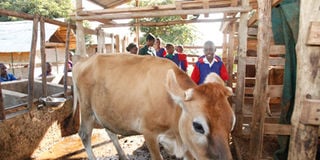Prime
The journey to developing tick-borne disease vaccine

Cows infested with ticks can get stunted. Photo | Rachel Mabala
What you need to know:
- Traditional methods for the control of tick infestations have been based on use of acaricides, repellents, antibiotics, cattle breeding and extension education about recommended practices to reduce exposure to ticks.
Cattle tick parasites affect animal health, production and welfare, particularly in tropical and subtropical countries.
Experts state that particularly in Uganda, tick-borne diseases such as East Coast fever caused by Theileria parva, babesiosis, anaplasmosis caused by Anaplasma marginale and heart water caused by Ehrlichia ruminantium, affect cattle production with estimated losses of more than Shs4 trillion annually.
Traditional methods for the control of tick infestations have been based on use of acaricides, repellents, antibiotics, cattle breeding and extension education about recommended practices to reduce exposure to ticks.
In a study commissioned by Food ad Agriculture Organisation (FAO) in 2018 and carried out by Ugandan scientists it is stated that the problem of ticks and tick-borne diseases especially in Sub-Saharan Africa and in particular East Africa, present one of the biggest challenges to livestock production.
Based on the study findings, controlling ticks and tick-vectored diseases account for more than 50 per cent of the farmers’ running costs in Uganda. Dr Sam Okuthe the head of the Emergency Centre for Transboundary Animal Diseases, states that projected livestock growth and GDP contribution is likely to be hampered by the problem of ticks and tick-borne diseases, alongside affected livelihoods, reduced trade earnings if the situation is not addressed immediately.
The livestock sub-sector contributed about 5 per cent of total national GDP. In addition, livestock contributes to the food and nutritional security and the livelihoods of farm families.
These facts encourage the development of vaccines as effective and environmentally sound control strategies for the integrated control of tick infestations and tick borne diseases.
As such, scientists at the National Livestock Resources Research Institute (NaLIRRI) have been conducting research since 2016 in a bid to come up with a vaccine to save farmers from the burden of tick-borne diseases.
Progress
The lead investigator of the anti- tick vaccine development, Dr Fredrick Kabi, tells Seeds of Gold that recent clinical trials provided them a ray of hope.
“Cattle tick infestations and transmitted pathogens affect animal health, production and welfare with an impact on cattle industry in tropical and subtropical countries.
Anti-tick vaccines constitute an effective and sustainable alternative to the traditional methods for the control of tick infestations. Subolesin (SUB) based vaccines have shown efficacy for the control of multiple tick species but several factors affect the development of new and more effective vaccines for the control of tick infestations. To address this challenge, we used a regional host tick species driven approach for vaccine design and implementation. The results showed that using SUB antigens for the control of multiple tick species in indigenous and crossbred cattle is effective for the control of cattle ticks in Uganda,” Dr Kabi says.
Process
Dr Kabi explains that ticks generally suck host blood and transmit several diseases resulting into anaemia, poor growth and poor weight gain and diminished productivity.
The diseases they transmit have continuously constrained Ugandan farmers from keeping improved livestock, let alone improving their local cattle breeds for higher milk yields due to the high susceptibility to diseases.
The target tick species include Rhipicephalus appendiculatus, R. decoloratus and Amblyomma variegatum affecting production of common cattle breeds.
Paul Kasaija, a scientist involved in developing the anti-tick vaccine, explains that at the laboratory level the scientists study the different stages of tick growth namely egg, nymph and adult.
They identify molecules in the gene of the ticks and carry out gene silencing of the molecule, which enables the ticks to transmit diseases and these are knocked out.
Once these molecules are removed from the ticks, the effect of disease transfer to the animals will be silenced.
Vaccination
For the three host tick species, approximately 300 larvae were applied on each animal. The larvae were enabled to expand for two weeks. The ear bags were then removed, and successfully expanded ticks counted, weighed and incubated for molting at 20°C and 95 per cent relative humidity.
A 15-day-old batch of 200 nymphs were applied on to each ear for two weeks and expanded nymphs were collected, counted, weighed and incubated for molting to adults.
Finally, 30 starved adult male and female ticks were applied on to the calf’s ear at a one male per three female ratio in the ear-bags.
After two weeks, the ear-bags were removed and expanded female ticks collected, counted, weighed individually and incubated for oviposition.
Eggs laid per tick were weighed for each calf and incubated for hatching. Larvae obtained from each egg batch were weighed. For the one host tick, R. decoloratus, approximately 300 larvae were applied on to each calf using a cell glued to the back of the animal.
The cells were left in position for 28–30 days to allow all the developmental stages to take place on the host.
The cells were then removed and adult ticks collected, counted, weighed individually and incubated for oviposition. The eggs mass per female tick was weighed and incubated for hatching.
This was to infest the animals with the tick-borne diseases and thereafter carry out vaccination. Blood samples were collected before vaccination three times in 45 days. Antibody response to vaccination with SUB has been shown to be the main protective mechanism against tick infestations.
This means when the animals are vaccinated, the anti-vaccine will cause immune response on the animals and when the tick comes to suck blood from the animal, the anti biotic will affect its feeding habit by weakening it.
Its reproduction is also affected in that once the females lay eggs, they will not hatch and this will control their population while some will end up dying after sucking blood from the vaccinated animal. Dr Kabi and team are now set to start multi locational trials where they will be able to test the vaccine on animals in selected farmer kraals for specified animal species before the vaccine can be rolled out for commercialisation.




